Hey, there, fellow birder!
I'm guessing you're booking a trip to the state, and you can't wait to see all the birds in North Carolina?
Well then...
You're in the right place because in this article, we'll talk about the wild and backyard birds in North Carolina that may just make you even more excited than you already are.
Let's get started, shall we?
The 18 North Carolina Birds And What To Know About Them
We have carefully chosen 18 species that you may want to see while bird watching in the state.
The species range from large to small birds, native to migratory, and rare to common species. We have made sure that this wide range will make your birding experience much more memorable!
1. Red-Winged Blackbird (Agelaius phoeniceus)
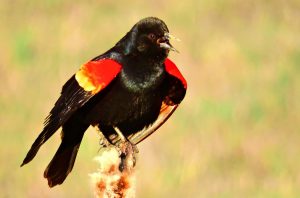
The Red Winged Blackbirds of North Carolina are about the size of a Robin. Their bodies are mainly covered in shiny black plumage, while their wings have a red to yellow fading patch.
Their plumage makes them easier to spot since it sets them apart from the common plumages of backyard birds.
These birds spend their time walking on the ground, shrubs, and trees rather than flying or perching. When they forage, they like to join flocks of other relative species like starlings.
Although most of their diet is seeds, they eat almost nothing else but insects and arthropods during summer. They may snack on berries and tiny fruits every once in a while.
The Red-Winged Blackbird species are highly polygynous. Unlike most birds, the male species mates with multiple females.
2. Indigo Bunting (Passerina cyanea)
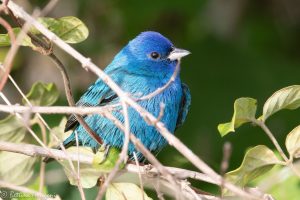
Indigo Buntings are small backyard birds that have bright blue feathers with black streaks on their tips. They have short conical bills and tiny feet.
You may notice that these birds are constantly foraging for food; during summer, they forage alone and join flocks when the winter comes.
Their diet mainly consists of seeds and insects that they take from leaves, stems, shrubs, and the ground. Their young are only fed insects at first.
In the western Great Plains, the Indigo and Lazuli Buntings are well known for sharing songs and interbreeding but never sharing territories.
3. Carolina Wren (Thryothorus ludovicianus)
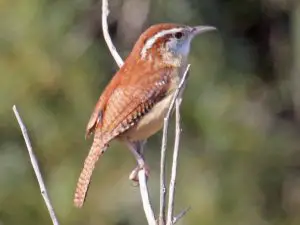
Compared to other birds in North Carolina, these Wrens are both tiny and quiet, which only makes them harder to identify along with their camouflaging plumage.
These birds are covered in chestnut brown feathers and have both light and dark brown streaks on the bottom part of their wings and tail. Their faces are light gray and have a white line from their eyebrows to their napes. They have long beaks and legs as well.
The Carolina Wren species is native to both East and SouthEast America. They are commonly found in woodlands and thick vegetation, but they also visit bird feeders with suet, sunflower seeds, and peanut husks.
These birds usually forage in pairs; they primarily eat many kinds of insects and arthropods. During the winter, they are fond of fruits, berries, and seeds. Fun Fact
Unlike other Wrens of the genus, Carolina Wrens are the only species whose males sing loud songs.
4. Downy Woodpecker (Dryobates pubescens)
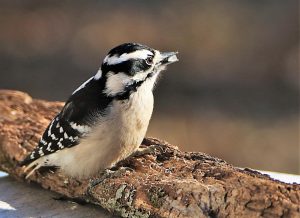
Downy Woodpeckers are tiny birds with interesting plumages. Their bodies are mainly light grayish-brown while their heads and black wings with white stripes and dots. They are very similar to Hairy Woodpeckers, but they are generally smaller in size.
These birds are non-migratory and commonly reside in most countries and provinces. You may spot them along streams and river banks.
They are also acrobatically skilled, foraging almost all parts of trees, shrubs, and weed stalks. You may also attract them to your bird feeders as they are not very shy birds.
Downy Woodpeckers join mixed-species flocks during the wintertime for extra protection against predators and quicker food foraging.
5. White Breasted Nuthatch (Sitta carolinensis)
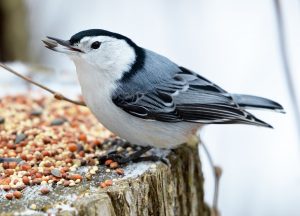
White Breasted Nuthatches are tiny and plump birds with solid-colored feathers. their faces and underparts are white, and they have a black cap and nape. Their backs, wings, and tails are pale blue with black streaks.
They are only visitors to the state during migrating seasons and commonly reside in coniferous and deciduous forests. Some of them may be found along bodies of water, roads, and large trees.
The diet of these birds is mainly made up of insects and seeds, depending on the season. However, their young are strictly only fed insects and arthropods.
If you ever try to attract White Breasted Nuthatches to your feeders with seeds, suet, and peanut butter mixtures and notice that they are going back and forth, this means that they are storing the food from your feeder to the nearby barks of trees.
6. Blue Jay (Cyanocitta cristata)
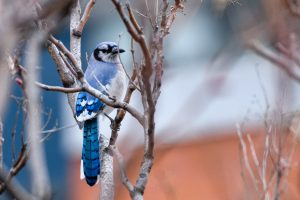
Blue Jays are famous birds with incredibly interesting plumage. They have white bellies and light blue backs and wings. The tips of their tails and the entirety of their tails have patterns of both light and dark blue and white on the ends. Their faces are mostly light gray with lines of black along their eyebrows, cheeks, and napes.
These birds live in Eastern North America and are non-migratory. Although there are rare events where some birds may fly west during the winter.
They are omnivorous birds; their diets consist mainly of vegetable matter. They are extremely fond of acorns, nuts, seeds, berries, and small fruits, so make sure to ready your bird feeders.
Blue Jays have the habit of harvesting food and storing them in the holes in the ground, mainly for wintertime.
7. Northern Mockingbird (Mimus polyglottos)
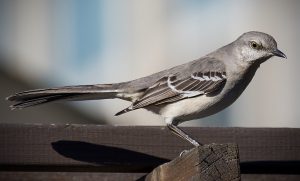
The Northern Mockingbird is a rather thin bird with a small head, long legs, and a very long tail (which takes over 40% of its body length). Its body is covered in feathers of different gray shades ranging from dirty white to black.
You may spot them walking and even running on the ground; they also often perch from low elevations of shrubs and trees.
Would you believe that this species has the ability to learn up to 400 unique songs in their life?
These birds sing all day and sometimes even during the night. But the nocturnal singers are often unmated males.
Much like most backyard birds, they eat insects and berries; Northern Mockingbirds have a way of completely relying on either one of these depending on the season (mostly insects during spring and summer while they eat mostly berries during fall and winter).
8. Red Bellied Woodpecker (Melanerpes carolinus)
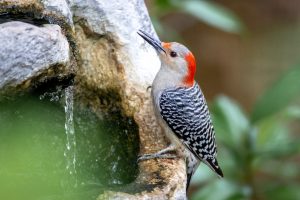
The Red Bellied Woodpecker species is generally easy to differentiate from most woodpeckers since they lack the red cap.
They are about the same size as most woodpeckers with their long bodies, beaks, and legs. They have paler bellies, necks, and faces but still have the common black and white woodpecker patterns on their wings and backs.
Red Bellied Woodpeckers are native to the Eastern States. They do not migrate and are present in selected states all year round.
If you ever find this species putting food in between bark crevices, it can only mean two things: either they are storing food for the later season or trying to break them into smaller pieces with their strong beaks.
Their diets consist of insects, arthropods, fruits, nuts, acorns, and plants. But on occasion, they may eat their own nestlings, sap, and even small fish.
The Red-bellied Woodpecker eats insects and spider seed, fruit, and nuts. Sometimes, the bird eats nestlings.
9. House Finch (Haemorhous mexicanus)
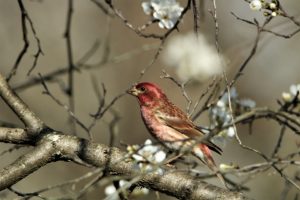
House Finches are birds that are often confused with Purple Finches. They are about the same size and have very similar feather patterns. They may be differentiated in color (House Finches are lighter) and on their beaks (a Purple Finch's beak is not curved).
A House Finch mainly has a fading red plumage with brown and black wing bars. Their underparts are pinkish white.
These birds were first known as Hollywood Finches. They were meant to be sold as cage birds but were later released on Long Island due to a lack of buyers. They rapidly bred across Eastern America and Southern Canada within 50 years and have now outnumbered Purple Finches.
You may spot them on farms, backyards, parks, and almost anywhere. These birds are noisy and hard to miss; some people call them a nuisance. They always forage in flocks, the only time you'll see them alone is when they nest.
House Finches mainly eat seeds and berries. They are not huge fans of insects, unlike most birds. You may easily attract them with nyjer and sunflower seeds in tube feeders and platforms.
10. Carolina Chickadee (Poecile carolinensis)
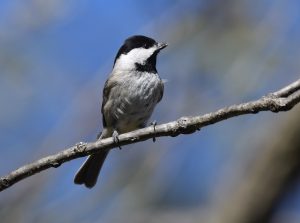
Carolina Chickadees are tiny birds that have a similar appearance to Black-Capped Chickadees as they have the tendency to interbreed with them.
These birds have grayish bodies and white striped faces with black caps. Their beaks and legs are extremely small, while their tails are wide and long.
They are present throughout the state and can be found in deciduous forests, parks, and backyards.
One of their cutest behaviors is the way they hop between twigs and branches with their small feet. They also store food in hard-to-reach areas and retrieve them later on.
Their diet is covered by insects, berries, and seeds. They are huge fans of black oil sunflower seeds, yam seeds, suets, and peanuts in tubes, cages, and platform feeders. If you offer them a nest box, they'll surely use it.
Mates within this species tend to remain intact for many years, sometimes even the entirety of their lifetime. This is unique compared to common birds with multiple mates throughout their lives.
11. White-throated Sparrow (Zonotrichia albicollis)
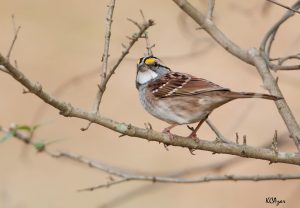
White Throated Sparrows are medium-sized birds with round bodies. Their plumages are similar to most sparrows, but their appearance differs when it comes to their faces. As the name suggests, they have white throats, bright yellow eyebrows, grey cheeks, and black lines over their faces.
They are migratory birds that commonly breed in Canada and migrate to Northern and Eastern parts of America during winter. Their habitats are mostly forests and dense areas. These birds love foraging on the ground, shrubs, and trees. They mostly eat seeds, berries, and insects depending on the season.
You may not believe it, but White-Throated Sparrows and Dark-Eyed Juncos occasionally mate and produce hybrids.
12. Eastern Bluebird (Sialia sialis)
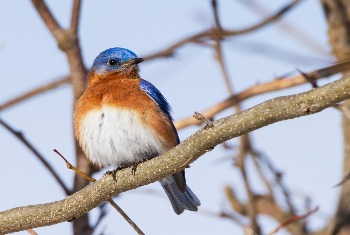
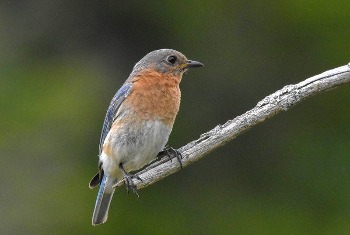
Unlike common birds, Eastern Bluebirds have plump heads and bodies and barely any neck. On the other hand, their eyes, beaks, tails, and legs are short.
Males have bright royal blue feathers above, golden orange chests and sides, and white bellies. Females, on the other hand, tend to have duller blue, orange, and gray feathers.
These birds are year-round in SouthEastern states and breed in the North. They nest in meadows and trees. They forage by perching on low elevations and fluttering around. One of their interesting habits is catching insects mid-air.
Eastern Bluebirds love insects of all kinds. However, they switch their diet to berries and tiny fruits during winter.
The male birds of this species tend to bring attention to a nest by either going in and out of it or flapping their wings around it to attract a mate.
13. Tufted Titmouse (Baeolophus bicolor)
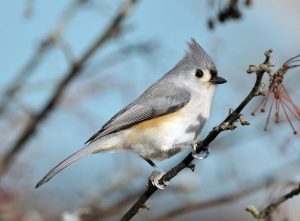
Tufted Titmice are round and plump birds with sharp crests, beaks, and tails. They have a mixture of grey and white over their bodies, black wing bars, and a pale yellow line below.
They reside all year round in both Eastern and Southeastern America. They most often reside in woodland parks, backyards, and forests.
You may find these birds hopping non-stop among branches and twigs, hanging upside down, and hovering for long periods. Their behaviors are truly interesting.
They eat insects and arthropods during the summertime while they snack on seeds, nuts, and fruits on feeders during winter. You may attract them to your bird feeders. However, it is important to know that they are aggressive and have the tendency to fight other birds that share the feeder with them.
A Tufted Titmouse would most likely hoard food during fall and winter -- a behavior they share with most chickadees and tits.
14. Yellow-Rumped Warbler (Setophaga coronata)
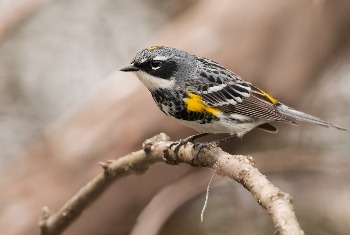
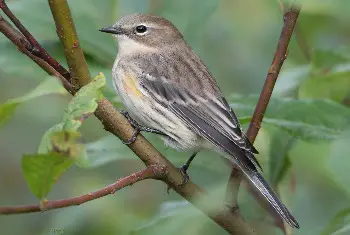
Yellow-Rumped Warblers are birds with interesting feather patterns.
Their long and plump bodies are covered with shades of black, grey, white, and a striking bright yellow while females tend to be lighter in color. They have long tails and legs while their beaks are sharp and thin.
These birds are native to Canada and migrate to certain parts of America during wintertime. Conifer woodland edges, open areas, and shrubs are their favored habitats.
One thing about Yellow-Rumped Warblers is that they are very industrious when it comes to foraging for food; they don't leave a single twig or leaf unturned. They will forage on the ground, mid-air, and in high areas just to find their food.
They snack on multiple types of insects and berries; this species has the ability to go farther north because, unlike most warblers, they can digest wax coatings of most fruits.
In winter, they forage in flocks with relative species, but during the breeding season, the males tend to forage in very high elevations compared to females.
15. Northern Cardinal (Cardinalis cardinalis)
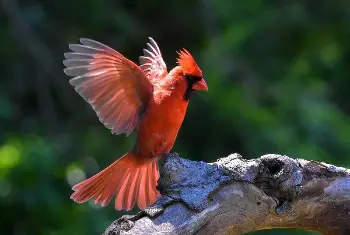
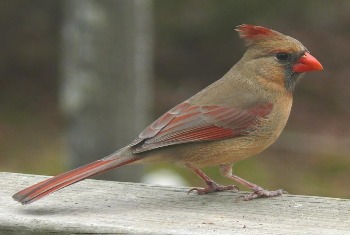
Unlike other birds you may spot in the state, Northern Cardinals are rare, extremely beautiful, and meaningful as well.
Multiple cultures, religions, and other beliefs have their own explanations of what it means to see a Northern Cardinal. The most common belief is that this bird is a visitor from heaven, most likely a loved one who has recently departed.
These birds have long bodies, a sharp crown, thin wings, widely spread tails, and big conical beaks. Their plumage varies depending on the gender; males have an overall striking red plumage with black masks and wingtips, while females have dirty brown bodies and gray masks.
They reside throughout the western half of America and in selected Southern and Western states of Arizona. They are usually found in dense vegetation and on the ground. Although they are rare, there is still a chance they visit your bird feeders if you fill them with their favorite sunflower seeds.
They have a varied diet that is split into three types: seeds, vegetable matter, and insects.
16. Song Sparrow (Melospiza melodia)

Song Sparrows are tiny little birds with short conical beaks, long slender legs, and short tails. Their bodies are covered in multiple streaks of light brown, chestnut brown, and black.
They are commonly spotted on the ground but are sometimes seen near shallow bodies of water.
These birds are extremely easy to attract since they are populous in the state of North Carolina. You just have to fill a feeder with sunflower seeds and position it near trees and shrubs so they'll feel safe.
They also eat insects of multiple kinds, including beetles, caterpillars, wasps, and their favorite spiders. Some birds that reside in coastal areas and islands snack on bread, mollusks, and very small fish.
Song Sparrows are among the most populous compared to other birds in North Carolina -- they have about 31 subspecies which is more than any other bird in Northern America has.
17. Dark-Eyed Junco (Junco hyemalis)
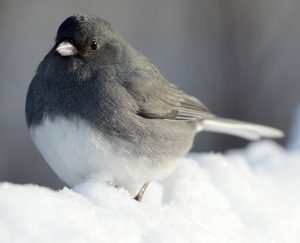
Dark Eyed Juncos are sparrows with round plump bodies, short conical beaks, and thin long tails. Their plumage varies depending on the state they reside in; In North Carolina, these birds have dark grey feathers from their heads to their wings, chests, and sides, while their undersides and rumps are white as snow.
Aside from having snow-like feathers, they are also known as winter birds since they only appear in Eastern North America during winter, leaving for Northern America when summer comes.
They are non-migratory birds that have resided in Northeast and West America their whole lives and are commonly found in partially-wooded areas.
These birds love to hop and run on the ground, which is an adorable sight to see! They sometimes even scratch the ground with their feet.
If you're thinking of seeing them up close, you can always attract them with a ground or tray feeder. You can fill these with black oil sunflower seeds, nyjer, corn, millets, and peanuts.
During the summer, they mostly prefer insects like caterpillars, beetles, tree bugs, and arthropods.
18. Mourning Dove (Zenaida macroura)
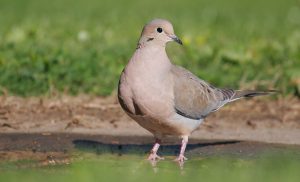
Mourning Doves are known for their big plump bodies and tiny little heads, an adorable combination indeed. Their plumage is a mixture of shades of brown, from very light to almost dark. Their tails and beaks are long, and they have thick feet.
These backyard birds are very easy to spot as they can be seen on roadsides, post wires, and cables, or mainly on the ground of open terrains.
Due to their body proportions, these birds prefer to walk and perch when looking for food, but don't worry; they still visit feeders with crops and any type of seed. They also eat grass, grains, weeds, plants, snails, and insects from time to time.
Mourning Doves are capable of drinking brackish spring water without getting dehydrated compared to humans and most animals.
Bird Point: Continue your birding adventure by reading our post on Louisiana birds -- Birds Of Louisiana: A Score Of Backyard Pals You Cannot Miss.
Watch This!
Frequently Asked Questions
How many types of birds are there in North Carolina?
The state of North Carolina serves as a comfy home to more than 340 beautiful bird species, both year-round and migratory. This makes the state one of the birdwatching capitals for enthusiasts.
What is the tallest bird in North Carolina?
The Great Egret (Ardea alba) is a bird species in North Carolina that stands three feet tall. They are commonly found foraging in shallow bodies of water, specifically freshwater, ponds, and lakeshore waters.
What is the rarest bird species in North Carolina?
The Varied Thrush and the Vermilion Flycatcher are among the rarest birds in North Carolina. You sure are one lucky birder if you spot one in the state.
What is the biggest bird in North Carolina?
The Osprey (Pandion haliaetus) is the largest bird in North Carolina; it is two feet tall and has a 6-feet long wingspan. Although you may assume that this bird is taking advantage of poor little nestlings, they actually are fish-eating prey, so you can commonly find them near bodies of water.
Conclusion
You have now reached the end of our guide to the common North Carolina Birds. Have you chosen your favorite species yet?
Never forget proper equipment, and remember, if you're having trouble identifying a bird, always use the four visual keys: size & shape, behavior, habitat, and color pattern.
We wish you a birdwatching experience to look forward to!

